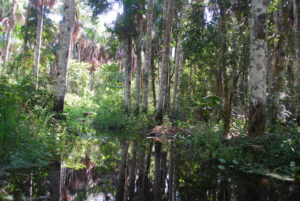 The World Wildlife Fund (WWF) and the Mamirauá Institute for Sustainable Development in Brazil have just released a report, “New Species of Vertebrates and Plants in the Amazon 2014-2015,” describing the new species of plants and animals discovered in the Amazon during 2014 and 2015. During those two years, researchers found a grand total of 381 new species, which means they found a new species roughly every two days.
The World Wildlife Fund (WWF) and the Mamirauá Institute for Sustainable Development in Brazil have just released a report, “New Species of Vertebrates and Plants in the Amazon 2014-2015,” describing the new species of plants and animals discovered in the Amazon during 2014 and 2015. During those two years, researchers found a grand total of 381 new species, which means they found a new species roughly every two days.
The researchers behind the report studied peer-reviewed journal articles published in 2014 and 2015 describing newly discovered species. Scientists had found 216 plant species and 93 fish species. They also found 32 amphibians, 19 reptiles, and one bird. Of the 20 mammal species scientists found, two were fossils.
The report indicates that the rate of discovery is increasing; a previous report by the WWF had described species discovered between 2010 and 2013. During that time, scientists described 441 new species or about one new species every 3.3 days. The increasing pace of discovery indicates that many more species in the Amazon are still unknown to science. An update of the 2010-2013 report was added to the new report.
The Amazon is huge, and it makes up nearly one third of the tropical rainforests left in the world. Scientists estimate that it contains about ten percent of the known species living on Earth, despite covering only about one percent of the planet’s surface. Scientists also believe that 80 percent of the species living in the Amazon have not yet been identified.
Ominously, many of the newly-discovered species are already critically endangered. The fire-tailed titi monkey (Callicebus miltoni) was first formally described in 2015. It lives in Mato Grosso in the south of Brazil, and the area is threatened by deforestation. The Araguaian boto or river dolphin (Inia araguaiaensis) is a new species of pink river dolphin, which is important to the cultures around the Amazon and appears in a number of legends and myths. Scientists have estimated there are 1,000 individuals in the species, and they are threatened by hydroelectric dams and agricultural, cattle ranching and industrial activities.
Sarah Hutchinson, the WWF Head of Programs Brazil and Amazon, called the report a “wake-up call” and said that the governments of the countries surrounding the Amazon needed to stop deforestation in order to prevent the habitat loss that was threatening so many species. She warned that some species could go extinct before scientists even had a chance to study and appreciate them.




